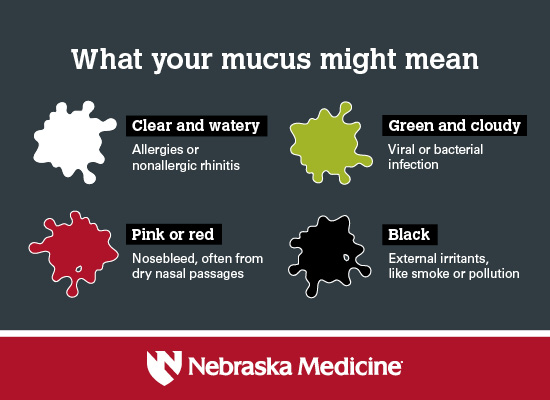
When you have a sinus issue, the mucus color and consistency can tell you a lot about what you’re experiencing.
Spoiler alert: The best way to find out if you have COVID-19 is to get tested. Call 402.472.5000 to schedule a test at the University Health Center. With that public service announcement out of the way, here are what different types of mucus might indicate.
Clear and watery: allergies or nonallergic rhinitis
Clear drainage tends to be associated with early onset of a cold, seasonal allergies or nonallergic rhinitis. If it's allergies, that tends to be accompanied by itchiness, watery eyes and sneezing.
Nonallergic rhinitis is a drippy nose that could have several causes, including exposure to irritants or hormone shifts.
But clear drippy drainage out of just one nostril could signal a serious condition called cerebrospinal fluid rhinorrhea. That raises the alarm for anyone who has experienced head trauma, for example after a car accident or skull fracture. If only one nostril is gushing watery discharge, seek medical attention right away.
Green and cloudy: viral or bacterial infection
Cloudy, discolored drainage – like green or yellow – usually means a viral or bacterial infection. If it's bacterial, you could see your doctor for an antibiotic or you might need to just give it some time. If it's a viral infection, antibiotics won't do you any good.
A lot of the symptoms of viral infections – fever, cough, headache, loss of smell – overlap for COVID-19 and other viral infections like the flu, respiratory syncytial virus and the common cold. That's why COVID-19 testing and seeing a doctor is so important. If you have symptoms, call 402.472.5000 to get tested at the University Health Center.
You can treat most infections with rest, hydration and symptom control.
Whether it's COVID-19 or another contagious illness, please stay home if you're sick. Don't go out in public or to work. Ask someone healthy to get you groceries or medicine or use at-home delivery.
Pink or red: nosebleed, often from dry nasal passages
Sometimes after (or during) an infection, your nasal discharge can turn pink, especially if you've been blowing your nose a lot. Usually, this isn't a big concern – a saline spray or a humidifier may help.
Black: external irritants, like smoke or pollution
Black drainage is uncommon, but it can happen. It can occur after spending time outside when there were a lot of fires or if you live in or travel to a city with a lot of pollution.
No matter the color or consistency of your mucus, it’s important to remember that many people suffer from sinus disease. Your sinus health is important to address and impacts your well-being and quality of life.
If you are dealing with ongoing sinus issues, schedule an appointment with the University Health Center medical clinic by calling 402.472.5000. Depending on your symptoms, a referral to an ear, nose and throat doctor may be provided.